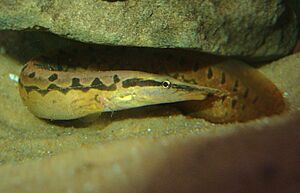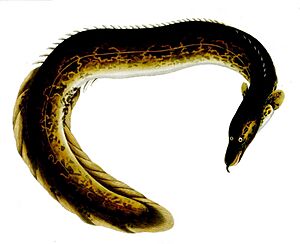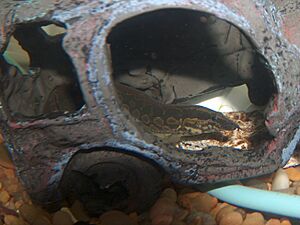Zig-zag eel facts for kids
Quick facts for kids Zig-zag eel |
|
|---|---|
 |
|
| Conservation status | |
| Scientific classification | |
| Synonyms | |
|
The zig-zag eel (Mastacembelus armatus), also called the tire-track eel or marbled spiny eel, is a cool freshwater fish. It's a type of ray-finned fish in the Mastacembelidae family.
You can find this unique fish in rivers across the Indian Subcontinent (like India and Bangladesh), Sri Lanka, Malaysia, Thailand, and other parts of South Asia and Southeast Asia. It was first described in 1800.
People love keeping the zig-zag eel in aquariums because of its interesting look and how it behaves. Also, like many other eels, it's an important food source for humans, water reptiles, birds, and bigger fish in its natural home.
Contents
Meet the Zig-Zag Eel: Appearance and Size
The Mastacembelus armatus is a long fish with a body shaped like a snake. It doesn't have pelvic fins. Its anal fin and dorsal fin are very long and connect to its tail fin. Before the dorsal fin, there are many small spines.
Its back is a dark beige, and its head is a shiny silver-beige. The rest of its body is a dull brown, with a lighter brown belly. You might see brown circular patterns on its body. It also has one to three darker zig-zag lines that connect to form a cool net-like pattern on the top two-thirds of its body. Brown stripes run across its eyes.
In the wild, these eels can grow up to 36 inches (91 cm) long. But in an aquarium, they usually don't get bigger than 20 inches (51 cm). Even though it looks like an eel, the zig-zag eel is not considered a true eel.
Zig-Zag Eel Habitat: Where They Live
Mastacembelus armatus are nocturnal fish, meaning they are most active at night. They love living in highland streams, lowland wetlands, and calm waters. You can also find them in coastal marshes and rivers. They prefer places with sandy or rocky riverbeds and lots of vegetation.
During the tropical summer, they are quite common. When the flood season arrives, they move into canals, lakes, and other areas that get flooded.
Caring for Zig-Zag Eels in an Aquarium
Zig-zag eels are popular aquarium fish. If you want to keep one, here's what you need to know.
Aquarium Setup: Home for Your Eel
These eels like to stay at the bottom of the tank. They also enjoy digging and burrowing into the substrate. A young eel, about 6 inches (15 cm) long, needs a tank that's at least 36 inches (91 cm) long and holds 35 gallons (132 liters) of water.
Bigger eels need much larger aquariums. For an adult, you'll need a tank that's at least 48 inches (122 cm) long and holds 55 gallons (209 liters).
Zig-zag eels do best in freshwater or slightly brackish water. You can make brackish water by adding two teaspoons of sea salt (make sure it's not iodized) for every 2.5 gallons of water. The water should have a hardness between 6 and 25 dH. The pH level should be between 6 and 8. Keep the water temperature between 73 and 81 °F (23 to 27 °C).
Be aware that M. armatus tend to pull up plants and move decorations around in their tank!
Tank Mates: Who Can Live with Your Eel?
Zig-zag eels can live with some other fish. They are often kept with medium to large-sized gouramis, knifefish, danios, loaches, and some types of catfish.
However, it's not a good idea to mix them with small fish. Tire track eels might try to prey on smaller tank mates. Also, it's best not to keep them with other zig-zag eels. They can be aggressive towards fish of their own kind, but they are usually peaceful with other species that have similar care needs, size, and personality.
Feeding Your Zig-Zag Eel
Since they are nocturnal carnivores, zig-zag eels hunt for food at night. In the wild, they eat insect larvae, earthworms, and some underwater plants.
In an aquarium, they need live foods in their diet. This can include small live fish, tubifex worms, brine shrimps, mosquito larvae, frozen bloodworms, cyclops, krill, and ocean plankton.
Reproduction: Life Cycle of the Zig-Zag Eel
It's hard to tell male and female zig-zag eels apart until they are fully grown. When they are mature, females are usually plumper than males.
Even though they have many babies in the wild, it's very difficult to get them to breed successfully in captivity. There are no known breeding programs for them in aquariums.




